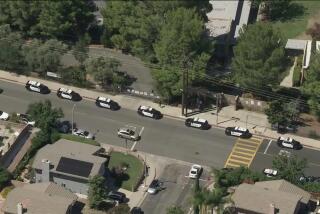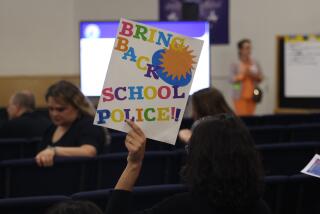Study Says School Violence Often Predictable, Preventable
- Share via
Evan Ramsey told friends to stand in the school’s mezzanine above the lobby if they wanted to watch him shoot the school principal to death. Word spread and 24 students showed up, one boy clutching a camera to record the event.
But no one told any staff member or administrator.
Ramsey, now serving a life term for killing the principal and another classmate five years ago in Bethel, Alaska, is a classic case of how such targeted school-based violence is often preventable, according to a study released Wednesday by the U.S. Dept. of Education and the Secret Service.
The report will be used at training sessions around the country to help school and law enforcement officials identify and stop potential student attackers. It recommends ways to build trust between other students and adults for the flow of such crucial information.
That may involve making sure every teen on campus is personally known by at least one teacher or counselor. And the guide urges schools to teach students that any inhibitions about squealing on others are less important than possibly saving lives.
The agencies examined 37 attacks during a 25-year period, including the 1999 Columbine High School bloodbath in Colorado that left 15 people dead, and found similarities in the perpetrators’ approach and personalities. The violent students usually discussed plans beforehand, had experience with weapons and were bullied. But not all had poor grades or a mental health history, as previously assumed.
The federal study, entitled “Threat Assessment in Schools,” found that in 30 of the cases an attacker had told at least one person beforehand. Nearly all of the attacks were planned at least two days in advance, with half planned for at least a month.
Even those who didn’t mention their plans showed evidence in their behavior before the attacks, including the student who asked his friends to help him get ammunition and went shopping with his mother for a trench coat.
The threat assessment process, modeled on the Secret Service’s program to prevent political assassinations, involves interviewing any identified student and his family to assess whether he poses any risk. An investigation follows to determine the consequences, whether it’s arrest, expulsion or referral for psychological help.
“Many schools approach the issue of threat assessment in an ad hoc manner,” said Bill Modzeleski, director of the education department’s Safe Schools Program. “If you don’t plan, you don’t practice, you don’t do this as a team, you’re not going to be successful in preventing violence.”
Officials emphasized that the guide only provides a basic framework and that different districts and schools apply the process in varied ways.
Key team members should include an administrator, teacher, mental health worker, nurse and school resource officer, with at least one of those people knowing the student well.
“We’re aiming to change the way prevention works by changing the culture and the climate of schools,” he said. “Oftentimes people want an easy answer or a shortcut, but there isn’t any way to cut corners on this.”
The California training session is free and will be held Aug. 14 to 15 in San Francisco. Session information and copies of the guide are available on the Education Department’s web site at https://www.ed.gov.
More to Read
Sign up for Essential California
The most important California stories and recommendations in your inbox every morning.
You may occasionally receive promotional content from the Los Angeles Times.










